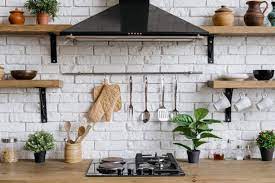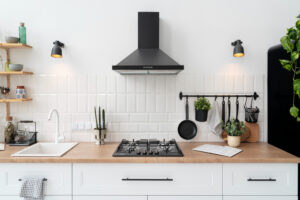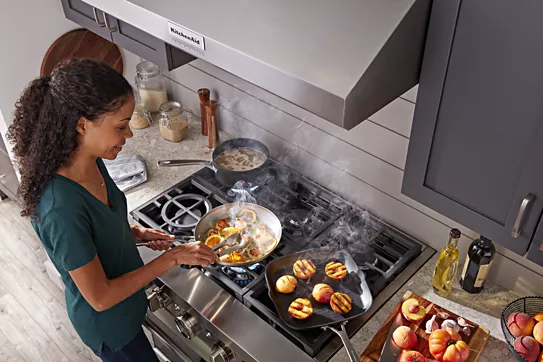When planning your kitchen layout, a common question that arises is How high should a range hood be? This simple-sounding query carries more importance than many realize, as it affects everything from ventilation efficiency to safety and overall kitchen aesthetics. Getting it right ensures your cooking space remains comfortable, clean, and enjoyable.
Choosing the right setup for your kitchen involves more than just picking appliances that look good. Every detail, from the countertop to the lighting, plays a role in creating a space that is both functional and inviting. One often-overlooked aspect is the placement of your range hood, which can significantly impact your cooking experience.
Standard Range Hood Heights

When installing a range hood, height placement is one of the most critical factors. The distance between the cooktop and the bottom of the hood affects both its performance and safety. A hood that is too high may not efficiently capture smoke, steam, and odors, while one that is too low can interfere with cooking and even become a fire hazard.
Standard Range Hood Heights
- For Electric Cooktops
The typical installation height for range hoods above electric stoves is 24 to 30 inches. Electric cooktops produce less intense heat compared to gas, so the hood can be installed a bit lower to efficiently capture fumes and smoke without being damaged by high heat. - For Gas Cooktops
Gas stoves generate more heat and flames, so range hoods are usually installed 28 to 36 inches above the cooktop. This extra clearance ensures the hood materials are protected from excessive heat and also allows for proper ventilation of smoke and combustion gases. - Under-Cabinet Range Hoods
For standard under-cabinet hoods, manufacturers often recommend a height of 24 to 30 inches above the cooktop. These are the most common type of range hoods in kitchens and fit snugly under the cabinets, providing both functional and aesthetic appeal. - Wall-Mounted Chimney Hoods
Wall-mounted hoods that extend above the cooktop usually require 28 to 36 inches of clearance, similar to gas hoods. Their design allows for higher placement while still capturing smoke effectively due to their wider coverage area. - Island Range Hoods
For hoods installed over kitchen islands, the recommended height is often 30 to 36 inches above the cooking surface. Since islands are open on all sides, the hood needs a higher and more centralized position to ensure proper capture of smoke and steam.
The “right” height depends on the type of cooktop, hood style, and kitchen layout. Most standard recommendations fall between 24 to 36 inches above the cooking surface, ensuring safety, efficiency, and optimal ventilation.
Factors That Affect the Ideal Height
Choosing the right height for your range hood isn’t just about following numbers, it’s about balancing efficiency, safety, and kitchen design. Several key factors influence the ideal placement above your cooktop.
Factors That Affect the Ideal Height
- Type of Cooktop
- Gas vs. Electric: Gas stoves generate open flames and more heat, requiring a higher hood (28–36 inches), while electric stoves produce less heat, so a lower hood (24–30 inches) works well.
- Hood Power (CFM Rating)
- A more powerful hood can be mounted slightly higher because it can still pull smoke, steam, and odors effectively. Less powerful hoods need to be closer to the cooking surface to capture fumes efficiently.
- Ceiling Height
- Kitchens with high ceilings may require extended chimney sections to maintain optimal performance, while standard ceilings allow for standard hood heights.
- Cooktop Size
- Larger cooktops or multiple burners need a hood that can fully cover the cooking area, influencing the height and width needed for proper ventilation.
- Kitchen Layout and Design
- Island hoods, wall-mounted hoods, and under-cabinet hoods all have design-specific height recommendations to ensure both function and aesthetic appeal.
- Material and Safety Considerations
- Some hood materials are sensitive to heat, requiring slightly more clearance from gas flames to prevent damage or fire hazards.
The ideal range hood height depends on a mix of cooktop type, hood power, ceiling height, and kitchen design. Paying attention to these factors ensures efficient ventilation, safety, and a well-balanced kitchen look.
Benefits of Correct Range Hood Height
Installing your range hood at the correct height isn’t just about aesthetics, it directly affects your kitchen’s air quality, safety, and cooking efficiency. When properly positioned, a range hood performs optimally, protecting both your food and your home environment.
Benefits of Correct Range Hood Height
- Optimal Smoke and Odor Removal
- A properly positioned hood efficiently captures smoke, steam, and cooking odors before they spread throughout the kitchen. This keeps the kitchen air clean and prevents lingering smells from reaching other parts of your home.
- Improved Safety
- Maintaining the recommended distance from your cooktop reduces the risk of heat damage or fire hazards, especially with gas stoves that produce open flames. It also prevents grease from accumulating in dangerous spots.
- Enhanced Cooking Efficiency
- Correct height ensures that the hood’s suction power works where it’s needed most. This means your cooking area stays clearer of smoke, making it easier to monitor food and cook comfortably.
- Energy Efficiency
- Hoods installed at the proper height work efficiently without overworking the fan. This helps save energy and prolongs the life of the appliance.
- Reduced Cleaning and Maintenance
- When a hood is too low or too high, grease and moisture can accumulate on cabinets, walls, and ceilings. The correct height minimizes this buildup, making routine cleaning easier and less frequent.
- Noise Reduction
- A correctly placed hood can operate more quietly because it doesn’t have to run at maximum power to capture smoke and steam effectively.
- Aesthetic Balance
- Proper installation height ensures the hood looks proportional to your kitchen layout, creating a visually pleasing design that complements your cabinets and cooktop.
Setting your range hood at the correct height maximizes ventilation, safety, efficiency, and overall kitchen comfort. It protects your home while enhancing your cooking experience, making it a smart investment for both function and style.
Common Mistakes in Installing Range Hoods

Installing a range hood seems simple, but small missteps can cause big problems. From poor ventilation to safety hazards, many homeowners unknowingly make mistakes that reduce performance and increase maintenance needs.
Common Mistakes in Installing Range Hoods
- Incorrect Height Above the Cooktop
- One of the most frequent mistakes is placing the hood at the wrong height. Too low, and it can obstruct cooking or even become a fire hazard with gas stoves. Too high, and it won’t capture smoke, steam, or odors efficiently.
- Choosing the Wrong Hood Size
- A hood that’s too small won’t cover the entire cooktop, allowing smoke and grease to spread. On the other hand, an oversized hood can overpower the kitchen’s aesthetics and may require unnecessary energy.
- Improper Venting
- Many people cut corners on ducting. Using the wrong duct size, too many bends, or venting into the attic can reduce suction, increase noise, and even cause moisture buildup that leads to mold.
- Underestimating Power (CFM) Requirements
- The fan’s CFM (cubic feet per minute) needs to match your cooktop’s output. A hood that’s too weak won’t remove odors effectively, while an overpowered hood can be noisy and drafty.
- Neglecting Electrical Requirements
- Failing to plan for proper wiring or outlets can make installation unsafe or force costly rewiring later. Some hoods require dedicated circuits for optimal operation.
- Ignoring Noise Levels
- A high-powered hood close to living areas can be loud and disruptive. Not checking decibel ratings before installation can lead to an unpleasant cooking experience.
- Difficult Maintenance Access
- Installing a hood without considering easy access to filters or lights can make cleaning difficult. Grease buildup over time reduces efficiency and shortens the hood’s lifespan.
- Skipping Manufacturer Guidelines
- Every hood comes with recommended installation instructions for height, ducting, and clearance. Ignoring them can void warranties and lead to performance issues.
- Poor Aesthetic Placement
- Even if functionally correct, a hood placed off-center, too high, or too low relative to cabinets and countertops can throw off the kitchen’s visual balance.
Avoiding these common mistakes ensures your range hood works efficiently, remains safe, and complements your kitchen’s design. Taking the time to plan installation carefully saves both frustration and future costs.
Tips for Measuring and Installing the Perfect Height
Getting the right range hood height is essential for safety, efficiency, and style. Measuring accurately and following best practices ensures your hood captures smoke and odors effectively while complementing your kitchen layout.
Tips for Measuring and Installing the Perfect Height
- Know Your Cooktop Type
- Determine whether you have a gas or electric cooktop. Gas stoves produce more heat and flames, so the hood should be higher (28–36 inches), while electric stoves allow for a slightly lower placement (24–30 inches).
- Measure from the Cooktop Surface
- Always measure the distance from the top of the cooktop to the bottom of the hood, not from the ceiling. This ensures proper clearance for smoke capture and prevents interference with cooking.
- Check Manufacturer Guidelines
- Each hood comes with recommended installation heights. Following these ensures warranty compliance and optimal performance.
- Consider Hood Width
- Ideally, your hood should extend at least 3 inches beyond the cooktop on each side. This ensures full coverage and effective ventilation.
- Account for Ceiling Height
- For tall ceilings, you may need an adjustable chimney or extension to maintain proper height above the cooktop. Don’t place the hood too high, or suction efficiency will drop.
- Mark and Level Before Drilling
- Use a pencil and level to mark the exact position for mounting brackets. Double-check measurements to avoid crooked installation or incorrect height placement.
- Ensure Proper Venting
- Plan your ductwork carefully. Shorter, straight ducts provide the best airflow. Avoid sharp bends or long runs that reduce the hood’s effectiveness.
- Check Electrical Access
- Ensure that outlets or hardwiring are positioned correctly for your hood’s power requirements. Some hoods need dedicated circuits.
- Test Before Final Fixing
- Temporarily hold the hood in place to check visual alignment, clearance from the cooktop, and access to filters. Adjust if needed before final mounting.
- Maintain Ease of Cleaning
- Leave enough space around the hood to easily remove filters and clean the unit regularly. This keeps it functioning efficiently and safely.
Measuring and installing your range hood at the perfect height ensures optimal ventilation, safety, and a balanced kitchen design. Taking careful measurements and planning ahead saves time, prevents mistakes, and maximizes your hood’s performance.
Conclusion
Choosing the correct placement for your range hood is crucial for both kitchen efficiency and safety. How high should a range hood be? is a key consideration that affects how well smoke, steam, and odors are captured while cooking. By planning carefully and considering your kitchen layout and cooking habits, you can ensure a more functional, comfortable, and visually appealing space.
It’s important to think about factors like cooking habits, stove type, and kitchen layout. Taking the time to plan carefully will help your kitchen function smoothly and look polished, making everyday cooking more enjoyable and hassle-free.

